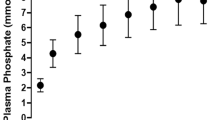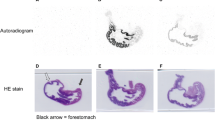Abstract
Aluminium (Al) intoxication in dialysis patients is held to be caused not only by Al in the dialysis fluid but also by Al from orally administered phosphate binders. Studies on Al absorption in patients and healthy individuals as well as in animals are still scarce, and do not provide sufficient data to characterize the absorption process.
This paper presents a method of studying the process of Al absorption in a perfusion system of rat small intestine in vivo, in combination with a cannulation system of the portal vein for serial blood sampling. Determination of concentrations of an absorbed substance in samples of both the perfusion medium and the portal blood, collected during the perfusion period, may clarify the nature of the absorption process. Although this method appears to be useful for the study of the intestinal absorption of any substance, it was adapted for the study of the intestinal absorption of Al compounds.
The usefulness of this method for studying Al absorption was demonstrated in an experiment in which Al chloride (0.5 g/l) in buffered media of pH 7.0, 7.5, and 8.0 was perfused through the rat small intestine over a period of at least 30 min. The results of this experiment indicate that a decrease in pH of the perfusion medium leads to an increase in absorption of Al in the portal blood.
Similar content being viewed by others
References
Alfrey AC, LeGendre GR, Kaehny WD (1976) The dialysis encephalopathy syndrome. Possible aluminum intoxication. N Engl J Med 294:184–188
Barr WH, Riegelman S (1970) Intestinal drug absorption and metabolism I: comparison of methods and models to study physiological factors of in vitro and in vivo intestinal absorption. J Pharmacol Sci 59:154–163
Berlyne GM, Ben-Ari JB, Knopf E, Yagil R, Weinberger G, Danovitch GM (1972) Aluminum toxicity in rats. Lancet 1:564–568
Berlyne GM, Rubin JE (1977) Aluminium ion: metabolism and toxicity. J Human Nutrition 31:439–442
Boulter JH, McMichael HB (1970) Modification of polyethylene glycol estimation suitable for use with small mammals. Gut 11:268–270
Cam JM, Luck VA, Eastwood JB, De Wardener HE (1976) The effect of aluminium hydroxide orally on calcium, phosphorus and aluminium metabolism in normal subjects. Clin Sci Mol Med 51:407–414
Clarkson EM, Luck VA, Hynson WV, Bailey RR, Eastwood JB, Woodhead JS, Clements VR, O'Riordan JLH, De Wardener HE (1972) The effect of aluminium hydroxide on calcium, phosphorus and aluminium balances, the serum parathyroid hormone concentration and the aluminium content of bone in patients with chronic renal failure. Clin Sci 43:519–531
Feinroth M, Feinroth MW, Berlyne GM (1982) Aluminum absorption in the rat everted gut sac. Mineral Electrolyte Metabolism 8:29–35
Flendrig JA, Kruis H, Das HA (1976) Aluminium and dialysis dementia. Lancet 1:1235
Gorsky JE, Dietz AA, Spencer H, Osis D (1979) Metabolic balance of aluminum studied in six men. Clin Chem 25:1739–1743
Griswold WR, Reznik V, Mendoza SA, Trauner D, Alfrey AC (1983) Accumulation of aluminum, in nondialyzed uremic child receiving aluminum hydroxide. Pediatrics 71:56–58
De Groot HJ, De Haas EJM, D'Haese P, Heyndrickx A, De Wolff FA (1984) Determination of aluminium in serum and hair of patients on chronic intermittent haemodialysis. Pharm Weekbl Sci Ed 6:11–15
Levine RR, McNary WF, Kornguth PJ, Le Blanc R (1970) Histological reevaluation of everted gut technique for studying intestinal absorption. Eur J Pharmacol 9:211–219
Lewis LD, Fordtran JS (1975) Effect of perfusion rate on absorption, surface area, unstirred water layer thickness, permeability and intraluminal pressure in the rat ileum in vivo. Gastroenterology 68:1509–1516
Manis JG, Schachter D (1982) Active transport of iron by intestine: features of a two step mechanism. Am J Physiol 203:73–80
Nathan E, Pedersen SE (1980) Dialysis encephalopathy in a non-dialysed uraemic boy treated with aluminium hydroxide orally. Acta Paediatr Scand 69:793–796
Parkinson IS, Ward MK, Kerr DNS (1981) Dialysis encephalopathy, bone disease and anaemia: the aluminium intoxication syndrome during regular haemodialysis. J Clin Pathol 34:1285–1294
Randall ME (1983) Aluminium toxicity in an infant not on dialysis. Lancet 1:1327–1328
Schedl MP (1966) Use of polyethylene glycol and phenol red as unabsorbed indicators for intestinal absorption studies in man. Gut 7:159–163
Thurston H, Gilmore GR, Swales JD (1972) Aluminum retention and toxicity in chronic renal failure. Lancet 1:881–883
Wills MR, Savory J (1983) Aluminium poisoning: dialysis encephalopathy, osteomalacia, and anaemia. Lancet 2:29–34
Author information
Authors and Affiliations
Rights and permissions
About this article
Cite this article
van der Voet, G.B., de Wolff, F.A. A method of studying the intestinal absorption of aluminium in the rat. Arch Toxicol 55, 168–172 (1984). https://doi.org/10.1007/BF00316122
Received:
Accepted:
Issue Date:
DOI: https://doi.org/10.1007/BF00316122




